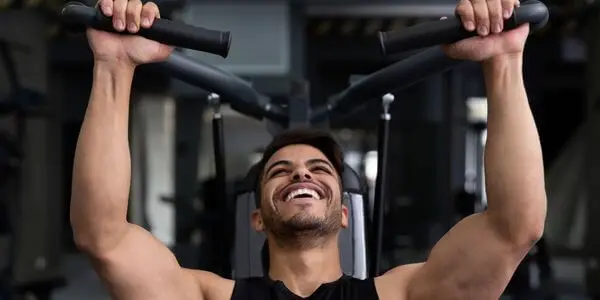Sculpted shoulders are incredibly sexy, whether you’re wearing a tank top, a strapless dress, or nothing at all.
But that’s not all.
Toned shoulders support your arm muscles, lifting your triceps to reduce the flabby arms look. And you also need strong shoulders to minimize the effects working on the computer all day has on your posture.
Gym machines for shoulders help you reap all those benefits.
But before we delve into that, here are some clarifications:
You’ll notice throughout this article and other guides that we advise for strong, slow, controlled movements. Unfortunately, beginners often go to the gym and start jerking the exercise machines up and down, using momentum to lift and lower the weights.
That’s not only inefficient for your muscles, but it’s also dangerous:
- Your muscles work much harder when you move slowly.
- You can focus better on your workout when you control your movements.
- Always controlling your movements means decreasing the risk of injury.
We also advise 2-3 sets of 8-10 reps each. That’s the golden minimum to reap good results without spending hours in the gym. However, you must pick a weight that challenges you specifically without compromising your form. This weight has to be heavy enough so that the final two reps of each set are challenging, but it shouldn’t ruin your form.
Table of Contents
Gym Workout Machines for Shoulders
That said, let’s begin:
Cable Cross Machine

The cable cross machine is one of the most popular gym machines for shoulders and other upper body muscles. Besides, this machine is very versatile because the cables move in various directions.
That means you can target your shoulders from different directions and through various movements.
That way, you can engage more muscle groups in your shoulders more effectively. And that’s how you can reach your goals faster.
Here are some exercises you can do using the cable cross:
Lateral Raises
- Fix the pulley at the lowest level.
- Face the pulley on your right side.
- Grab the handle using your left hand.
- Make a step or two until you feel resistance in your left hand.
- Lift your left arm perpendicularly to your body and then lower it again.
- Repeat 8-10 times.
- Do the same for the right arm.
- Do 2-3 sets for each arm.
Front Raises
- Fix the pulley at the lowest level.
- Insert the rope handle attachment.
- Keep your back to the pillar, straddling the pulley.
- Grab the handle and step slightly back until you feel enough tension.
- Raise the handle straight in front of you, keeping your arms straight.
- Do 2-3 sets of 8-10 reps each.
Upright Rows
Attach a straight bar to the cable set. You can also use the rope handle if you want to work on balancing your shoulders.
- Stand facing the pillar.
- Grab the bar, keeping your wrists towards the pillar.
- Don’t bend your wrists, and keep your hands shoulder-width apart.
- Pull the bar up towards your chest and then lower it back down to your thighs.
- Do 2-3 sets of 8-10 reps each.
Rear Delt Fly
- Attach handles to both cables.
- Grab each handle with the opposite hands so they make an “X” in front of you.
- Bend forward from your hips and open your arms.
- Keep your elbows slightly bent.
- Pull your shoulder blades together to activate the backs of your shoulders.
- Do 2-3 sets of 8-10 reps each.
Shoulder Press Machine
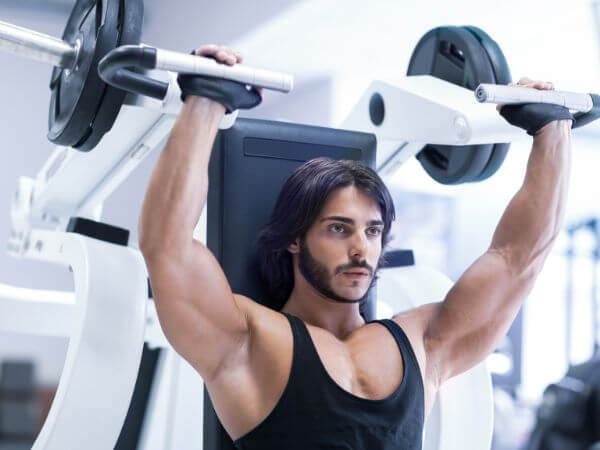
The shoulder press machine is pretty straightforward. You sit down, set up your weights and start pushing your arms upwards.
However, there are different shoulder press machines at gyms.
Some keep your back straight and your arms at a 90-degree angle so that you can focus on your shoulders entirely. Others are slightly bent, activating your pecs too.
If you have time, do 2-3 sets of 8-10 reps at each machine.
Remember to keep your elbows slightly forward to avoid injuring your shoulders.
Free Weights and Barbells
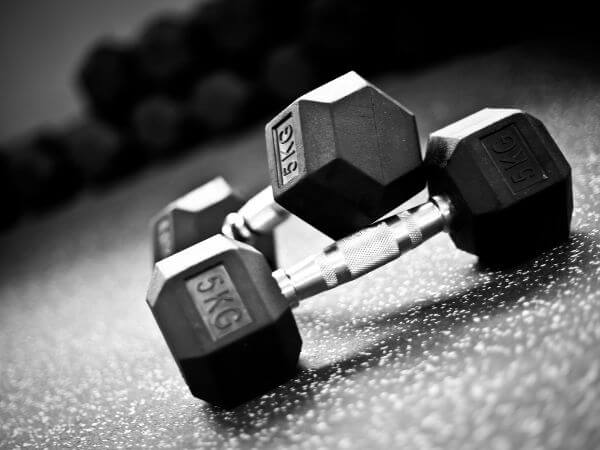
Free weights and barbells are technically not gym machines, but you can find them lying around there. So, why not make good use of them?
Who knows, you might fall in love with them and decide to buy some for your home gym.
The shoulder exercises you can do with free weights and barbells are similar to the ones above. You can try:
Overhead Presses
- Stand with your back straight and knees slightly bent.
- Keep your arms bent at a 90-degree angle.
- Raise them for a set of 8-10 reps. Do 2-3 sets.
Pro tip: Don’t keep your shoulders completely back. Bring them slightly forward to minimize the pressure on your shoulder tips and avoid injury.
Lateral Raises
Raising your arms laterally while holding onto free weights or resistance bands is an excellent shoulder exercise. Besides targeting the front and lateral shoulders, these exercises also engage your upper back.
- Stand with your back straight and knees slightly bent.
- Keep your arms straight by your sides.
- Raise them and lower them for a set of 8-10 reps. Do 2-3 sets.
Pro tip: Spice things up and increase the challenge by adding pulses at the top of each movement. Pair lateral raises with lunges or static squats to work out your entire body.
Front Raises
Front raises are similar to lateral raises, but you’ll lift your arms in front of you. The secret, again, is to keep a slight bend in your elbow.
Pro tip: Don’t lift from your lower back. If you have to lean back slightly, lean from your hips.
You can combine front raises with other exercises, too, such as curtsy lunges or deadlifts. If you’re doing deadlifts, you can turn front raises into ventral raises (aka lifting your arms while in a deadlift position).
Pullovers
Pullovers are the equivalent of pull-ups because they work similar muscle groups in your shoulders, arms, and upper back. However, pullovers are much easier to do than pull-ups, and so they can prepare you for your first future pull-up.
- Grab a mat and lie down.
- Keep your belly button tucked in, so your lower back doesn’t arch up.
- Grab some light dumbbells or a light barbell and raise it over your head, keeping your arms straight.
- Slowly lower your arms over your head, controlling the movement and avoiding any jerks.
- Bring the arms above your shoulders again.
- Do 8-10 reps and 2-3 sets.
Why choose free weights?
Gym machines for shoulders are best if you’re trying to isolate your shoulders. Focusing on just your shoulders means targeting these muscles with more precision. Therefore, you can gain more strength and build lean muscles in your shoulders faster.
Free weights help you target more body parts at once. The advantage here is saving time while toning your upper body. However, free weights are less precise, and you’ll have to focus more to keep your form correct.
That’s not necessarily bad.
Staying present during your workout exercises your brain and helps you practice mindfulness.
Besides, free weights are more adaptable and versatile. And you can always get a pair for home use.
Smith Machine
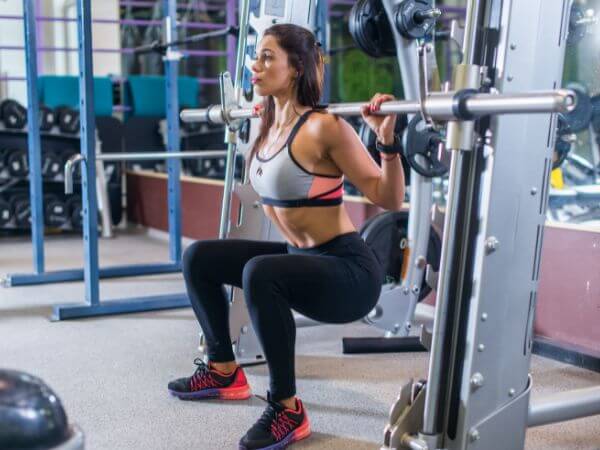
The Smith machine is one of the most popular and versatile gym machines – not just for your shoulders but your entire body. You can use it for shoulder presses, lateral raises, front raises and more.
The Smith machine is best if you’re trying to reap the versatility of free weights without the added balance challenge.
As such, this machine is perfect if:
- You haven’t used dumbbells before.
- You need extra support with your form because you’re recovering from an injury.
- You want to lift more weight and sculpt your shoulders faster.
The exercises you can try include:
- Overhead presses: Press the bar upwards without fearing it can fall on top of your head if you’re making a wrong move.
- Upright rows: This exercise feels more comfortable using the Smith machine than dumbbells because you’ll feel less pressure on your back and shoulders. You also get more muscle activation throughout your deltoids and the trapezius muscles. To reap these benefits, take a wider grip.
- Single-arm upright rows: This exercise is best for targeting your shoulders’ tips and lateral parts. Remember to squeeze your deltoids and trapezius muscles at the top of each movement for a second or two.
- Shrug: Select your weight and keep the barbell in front of your thighs. Your feet and hands should be shoulder-width apart. Use an overhand grip on the barbell, keeping your arms and back straight. Engage your core, too, then do a shrugging motion, using your shoulders to lift the barbell. Remember to do a slow, controlled movement, avoiding jerks. Otherwise, your risk of injury can increase dramatically.
Lat Pulldown Machine
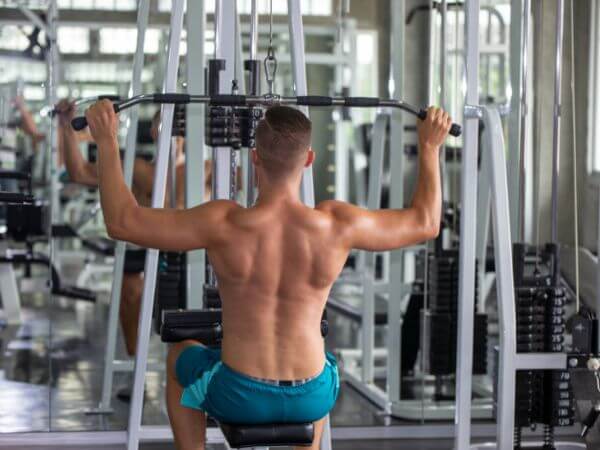
The lateral pulldown machine is excellent for targeting your shoulders and upper back. This machine is not a shoulder-specific piece of equipment, but it:
- Contributes to sculpting your shoulder muscles
- Builds functional strength in your upper body
Here’s how you should use it:
- Select the right weight for your needs. The weight should be challenging, so it’s difficult to execute the last 1-2 reps of each set. However, it shouldn’t be heavy enough to ruin your form.
- Sit on the seat and grab the handles.
- Pull the handles down, keeping your back straight and your core engaged.
- Do 2-3 sets of 8-10 reps each.
Lateral Raise Machine
Lateral raise machines look different because some have you sitting forward, while others have you resting your back on a seat. The first model requires more balance and effort from your lower back, while the second allows you to keep the correct form more easily.
But the principle is the same:
- You have to pick the correct weight (which isn’t going to be too much, especially if you’re a beginner).
- Adjust the machine to your body, so the pads rest on your elbows.
- Keep your elbows bent at a 90-degree angle.
- Raise and lower your arms slowly, using controlled motions.
- Complete 2-3 sets of 8-10 reps each.
Rowing Machine
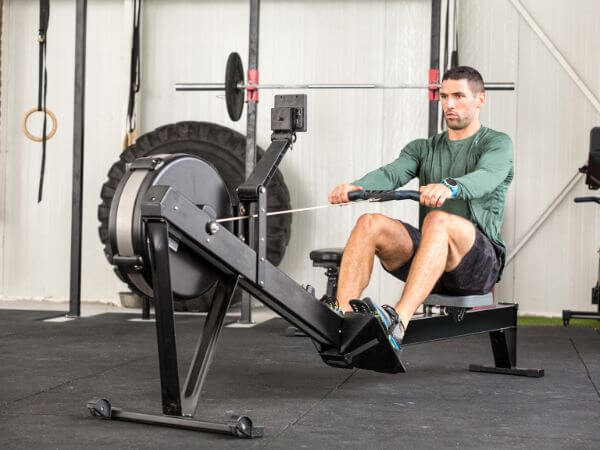
A rowing machine is another piece of equipment you can buy for your home gym. Of course, you’ll need to select the right model, taking into account factors like:
- Resistance: What type of resistance does it have? Is the machine scalable? Is the highest resistance level enough to challenge you? Are the resistance increments comfortable? We discussed more about rowing machine benefits here.
- Programs: You want to have enough built-in workouts to keep yourself motivated and challenge yourself.
- Adjustments: You want to ensure the rower is easily adjustable to your body shape to keep a correct form.
Why get a rowing machine?
A rower activates your entire body’s muscles, including your shoulders and upper back. That means it’s a very efficient way to train, reaching your goals faster – whether we’re talking weight-related or body composition-related goals.
Using the rowing machine is relatively intuitive:
You sit on it, grab the handles, and start rowing.
However, avoid the following newbie mistakes:
- Lifting your shoulders towards your ears
- Jerking movements
- Pushing too hard with your soles and knees, creating momentum
Spin Bike
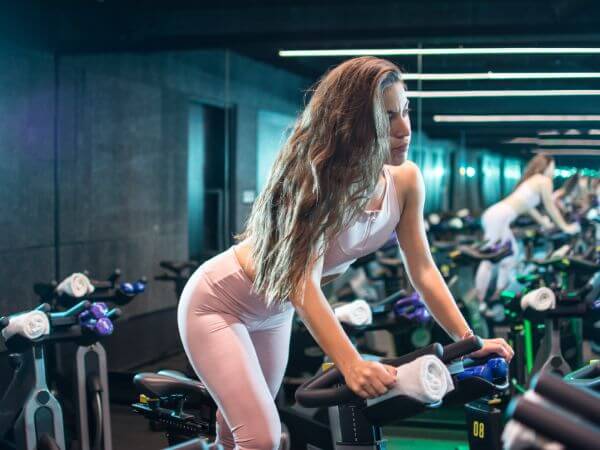
Spin bikes aren’t technically gym machines for shoulders, but they will give your shoulders quite the workout.
Besides, everyone knows that spinning burns a considerable amount of calories, releases stress, and tones all your muscles. And it’s a great way to sculpt your bum, which you can read about here.
Spinning works best for your shoulders when you’re:
- Standing with your hands on the handlebars. However, keep your elbows slightly bent to avoid putting too much pressure on your shoulders.
- Standing with your elbows resting on the handlebars. This position puts less pressure on your wrists but also engages your shoulders quite a lot.
Wrap Up
If you’re here, you now know which equipment you can try next at the gym. You also know which machines you could buy for home use.
You can also improvise and have fun at the gym.
Combine these machines in different ways. Vary the weights and number of sets/reps to see what fits you. And then add some bodyweight exercises too.
For example, you can do pull-ups on the bar, pike push-ups, or Yoga.
If you decide to purchase a spin bike or rower for home use, check their specifications to ensure they’ll fit all your goals.
- What Happens To Your Body When You Do Dips Every Day - June 28, 2024
- 9 Push-Up Mistakes You Might Be Making (And How to Fix Them) - October 10, 2022
- The Complete Guide to Mastering Upper Chest Push Ups - October 10, 2022

